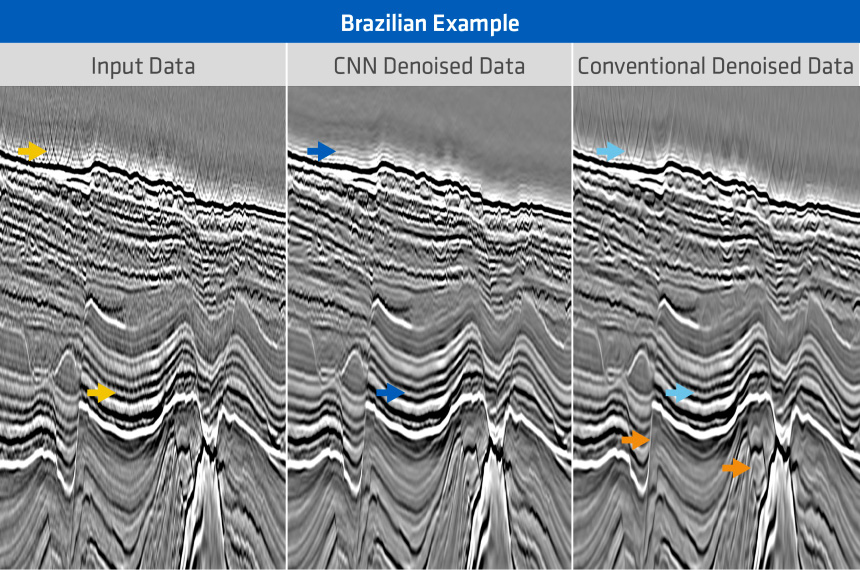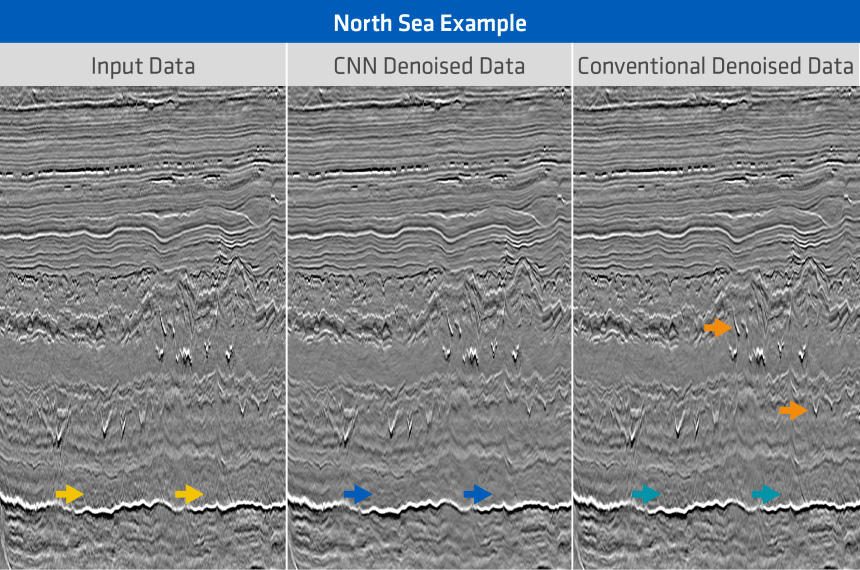In the paper, PGS demonstrate the transferability of a pre-trained model to two different field data sets. This successful application shows how pre-trained machine learning models may be commercially attractive for seismic processing.
Click here to read the full article, leveraging deep learning for seismic image denoising.
In seismic processing, the algorithm used for each geophysical task works independently of the data’s characteristics, for example, by applying the same noise attenuation algorithm to data from very different geological regimes. So that it works optimally, a geophysicist will test combinations of settings to achieve the best result from the process. Testing can take a significant amount of time and resources.
Trained Neural Networks Can Solve Challenges in Seismic Data Processing
Neural networks are used to solve a variety of problems, and they have recently gained attention in geophysics. Once trained, a challenge can be provided to the network to see if it can solve the problem based on its training regime. One hurdle is overfitting. This can happen when a network trained on a representative data set shows good results during the training, but is less effective on different data, hindering the network’s commercial viability.
"To monitor the performance and prevent overfitting, we split the input data into two parts. During the training phase, the model uses the majority of the data, and we observe its performance on the remainder. Assuming the training data set represents the challenge, both training and validation data sets should see consistent progress towards an optimal result. If this is the case, we can then check the network’s transferability to other unseen data. Should that be okay, we have a tool that does not need parameter testing like conventional geophysical algorithms, and we can use the pre-trained networks to reduce project turnaround times", explains PGS Principal Geophysicist, Tony Martin who co-authored the article alongside Elena Klochikhina, Sean Crawley, Sergey Frolov, and Nizar Chemingui.
Examples of Neural Network Applications on Two Differing Data Sets | Brazil and the North Sea
Described in July’s First Break, a deep convolutional neural network was trained by PGS to remove migration-related noise in stacked migrated images. This is a difficult challenge for conventional algorithms as the noise has similar characteristics to the desirable seismic signal in the data. The training and validation used synthetic data, and was augmented by varying the input data with flips, random crops and sign reversals, filtering and scaling. This resulted in approximately 100 000 input samples. Once validated, the network was used on unseen field seismic data from two different geological regimes, one deep-water data set from Brazil, and a shallow-water data set from the North Sea. The images below show the results. Both deep learning outputs are free of the noise (blue arrows – center panels) and perform much better than a fully tested conventional numerical algorithm (turquoise arrows – right panels).

A Well-Trained Numerical Network Can Save Time in Seismic Processing
Training a neural network may take time, but experience shows this may be no longer than testing parameters for a standard numerical process. However, if the network generalizes well to other data, once trained there is no need to retrain or test. A well-trained neural network may significantly reduce the turnaround of a seismic processing task, which is commercially very attractive.

Contact a PGS expert
If you have questions related to our business please send us an email.